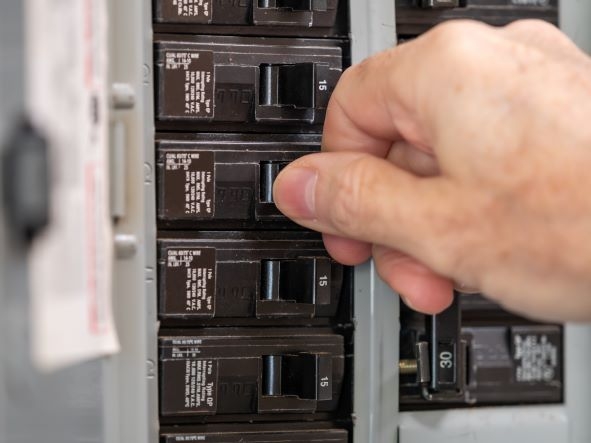Your home’s electrical system comprises many components that work together to ensure that you have power for your lights, appliances, and electronic devices. When you experience an issue with one electrical component, it can affect your entire system. This is particularly true of issues involving the circuit breaker. If you’re wondering how to reset or replace a circuit breaker, keep reading this guide to find out.
What Is a Circuit Breaker?
All your home’s electricity is distributed and controlled at one central hub, your electrical panel, which is also known as a breaker box. If you open the large panel, you’ll find a beehive of small circuit breakers stacked in columns and rows.
Each breaker controls a different circuit or branch of your house’s electrical wiring. One circuit breaker might be in charge of all of your outdoor lights, the next one might control your kitchen outlets, and the next might oversee specific larger appliances like your washing machine or air conditioner.
Circuit breakers act like bouncers posted at the doors of the electrical world to protect homes, workplaces, and other buildings and devices from potential disasters like electrocution and fire. The job of a circuit breaker is to monitor the amount of electrical current flowing through it. If the current gets too high, it can break the circuit to stop the flow of electrons and allow the wires to cool down. You can think of it as a switch that automatically flips off when things get too hot to handle.
There are two main kinds of circuit breakers: magnetic and thermal. Magnetic breakers are designed to react quickly to a short circuit or sudden spike in voltage. Thermal breakers are designed to protect against sustained overcurrent that can heat up devices over time and cause slow-moving train wrecks.
The most common breakers you’ll see in everyday use are thermal-magnetic breakers. These combine magnetic and thermal technology to provide protection against both short circuits and sustained overcurrent.
Can I Replace a Circuit Breaker Myself?
Although the circuit breaker replacement itself is pretty easy, it usually involves getting up close and personal with the live wires that feed your electricity. You’ll turn off the power to all the parts you need to touch during the circuit breaker installation, but the live wires that come in from the street might be just a few feet away, and they never turn off. If that makes you uncomfortable or if your electrical panel looks unusual, damaged, or old, call an electrician to help you sort things out.
Can You Replace a Circuit Breaker Without Turning Off the Main Breaker?
Professional electricians with an in-depth understanding of electrical systems sometimes leave the main power supply on when doing basic electrical renovations like replacing a breaker or even electrical panel replacement. If you’re unfamiliar with the detailed anatomy of your service panel and which parts are hot or not, it’s safest to flip the main breaker off when replacing circuit breakers.
How Do You Know if a Circuit Breaker Needs to Be Replaced?
Today’s circuit breakers have lifespans of around 30 to 40 years with gentle use. If a circuit breaker keeps tripping regularly, its internal components will wear down faster, and you’ll need to replace it sooner. Power surges, water leaks, and lightning can also damage breakers prematurely.
If you want to know how to tell if a circuit breaker is bad, here are a few signs to look for:
- Burn or melt marks, especially near the back
- Cracks in the case
- Burning smells
- Keeps tripping off with no load
- Worn springs that no longer snap the switch crisply on and off
- Problems with appliances hooked up to the breaker’s branch
What Is the Best Circuit Breaker Size?
The best circuit breaker size is generally about 125% of the electrical load you need for that branch. If you install a breaker with around 25% extra capacity, you won’t have to worry about your wires overheating during normal operation.
In most cases, when replacing a circuit breaker, it’s best to use the exact same make and model from the same manufacturer. You can take a picture of the old breaker’s label with your smartphone and compare it with the different models available at your hardware store.
The most important number on the label is the amp rating, which is usually a large 15 or 20. Other important numbers to match include the part number, the catalog number, and the manufacturer part number (MPN).
How to Replace a Circuit Breaker
Even if you turn off your main switch, working near electricity is always a bit risky. If you decide you want to accept the risk, enjoy this step-by-step guide on how to change a circuit breaker.
Tools and Materials
- Flathead screwdriver
- Roll of painter’s tape
- Multimeter or voltage detection pen
- Correctly sized replacement circuit breaker
- Flashlight (optional)
Step 1: Preparation
Start by turning off any appliances connected to the circuit with the faulty breaker. Next, find your electrical panel, and switch the faulty breaker off. Use a small strip of painter’s tape to mark it so it’s easy to find later.
Step 2: Turn the Power Off
Before anything else, find your main breaker switch, and carefully turn it off. It may be at the top of your electrical panel, or if you’re working with a subpanel, the main switch may be on a separate panel outside next to your meter.
Once the main breaker is switched off, use your flathead screwdriver to remove all your electrical panel’s screws. If the panel is heavy, it can fall out of position when you remove the top screws, so work from the bottom up, and make sure you have a good grip on it when removing the last few screws.
If you’re working with a main panel, the power will arrive from the utility via three bulky wires at the top of the panel above the main switch. You should see a thick aluminum wire in the center and two wires on the sides that are usually some combination of black and red. Turning off the main breaker cuts power to the circuits below, but those three wires above will still be live. Avoid touching them at all costs.
The three service cables at the top feed the panel’s hot busbars, which are the two metal strips running down the rear center of the panel that the individual circuit breakers snap into. You’ll also see one or more neutral busbars and a grounding busbar running along the outer edges of your panel.
It’s important to double-check that the power is off to prevent accidents. Use your multimeter or voltage detection pen to touch a few of the visible circuit breaker screws. If you don’t see any lights, alarms, or other activity in your multimeter or pen, you’re safe.
Step 3: Remove the Faulty Breaker
Circuit breakers aren’t usually screwed in; they simply snap in and out. Hold the edge of the breaker closest to the center of the panel, and pull the breaker outward steadily and firmly. You may find a bit of grease on the inside of the breaker. This is used to help it slide smoothly into the panel.
Step 4: Remove the Wires From the Faulty Breaker
If you have a standard single-pole breaker, you’ll see a single hot wire attached to it. If your panel uses the more modern AFCI or GFCI breakers, you’ll see one hot wire, usually black, connected to your electrical panel’s hot busbar and one or more neutral wires, usually white, connected to your panel’s neutral busbar.
Use your flathead screwdriver to remove the screws connecting the hot and neutral wires to the faulty breaker’s terminals. You only need to loosen them a bit, and then the wires will slip right out. Push the wires to the side, but make sure you remember which goes where.
Step 5: Attach the Wires to the New Breaker
Grab your new breaker, and connect the hot wire to its main terminal, which should be labeled “HOT” or “LOAD.” Make sure you insert the wire between the terminal’s small metal plates and not right under the screw.
Hold the wire in place as you tighten the screw so the pressure doesn’t force the wire out of place and give you a loose connection. You don’t need to ruin the screw’s head, but make sure the screw is really tight and has a secure grip on the wire. If your breaker has any neutral wires, attach them to their corresponding terminals using the same technique.
Step 6: Insert the New Breaker
Once all the wires are snugly attached, insert your new breaker into your service panel at an angle starting with the outside rear corner. Most breakers come with a notch on the outside rear corner and a slot on the inside rear corner. The notch slips into a mounting rail at the outer edge of the breaker panel, and the slot snaps into a clip on the hot busbar near the center of the panel.
Push the breaker’s outside rear corner into place until the notch locks into the mounting rail. Next, push the inner edge in until the slot snaps onto the busbar’s clip. You’ll feel a satisfying click. Once the breaker is in place, flip its switch on.
Finishing Touches
Now that the breaker is inserted correctly and there are no loose wires hanging around, it’s time to replace the electrical panel’s cover. Hold the cover in place in front of the panel and wiggle it a bit until it falls into position. Keep it in place with one hand or elbow while you screw all the screws back in, starting from the top. When the cover is in place, you can turn your main switch back on.
Conclusion
Replacing a circuit breaker is a simple task that will take you or your electrician only a few minutes. If you enjoyed this circuit breaker guide and are confident you can do it yourself, more power to you.
Have a look at True Value’s store locator page to find the closest store carrying the parts you need. With a little bit of spark, some elbow grease, and a good eye for safety, you may find that replacing a breaker is light work.












